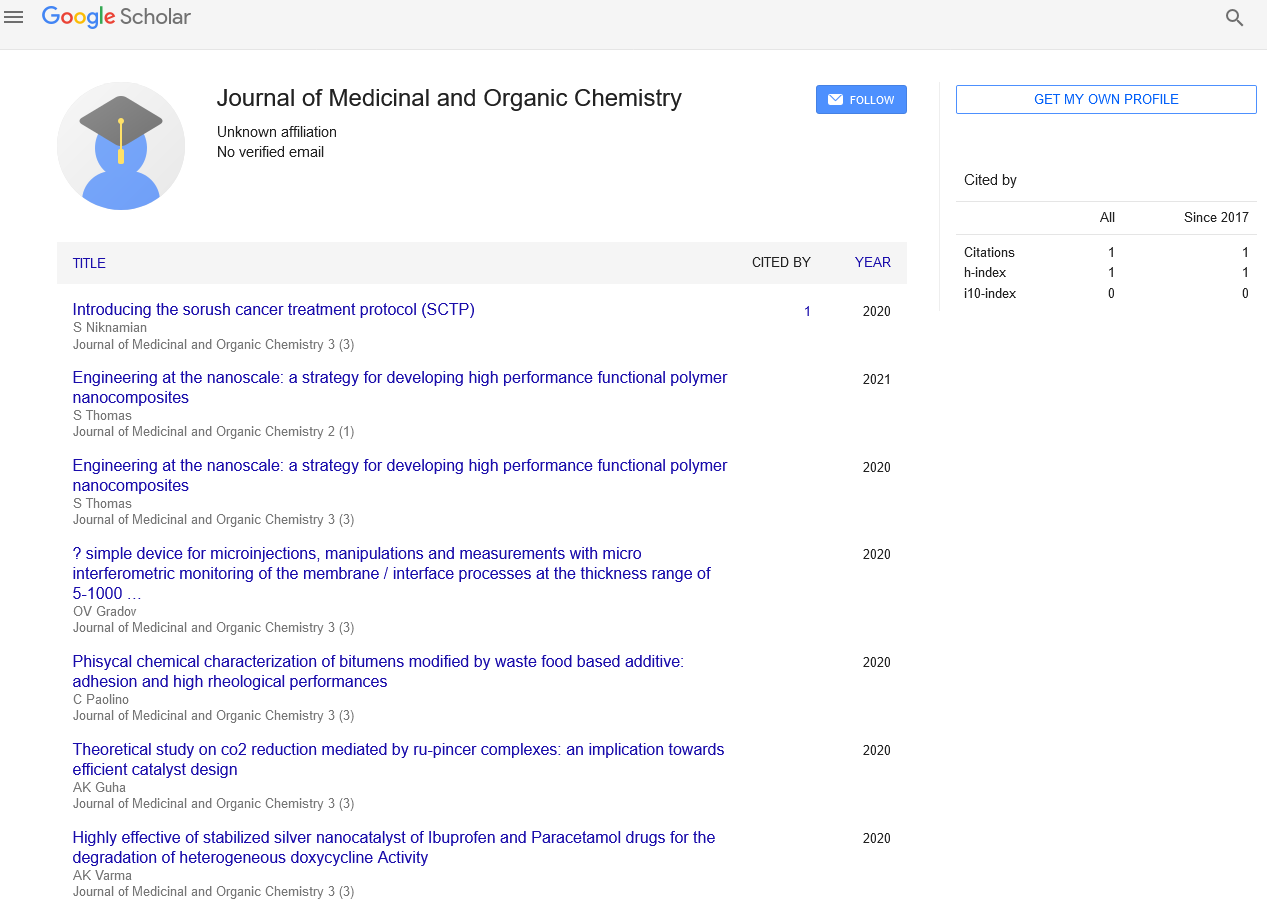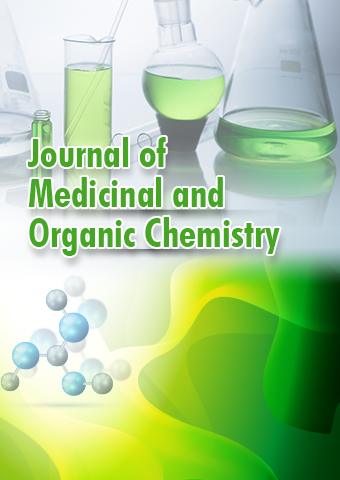Mini Review - Journal of Medicinal and Organic Chemistry (2023) Volume 6, Issue 3
Synthetic Medicinal Chemistry: Advancing Drug Discovery and Development
Dr. Hossein Sharifi*
Department of Medicinal Chemistry, University of Medical Sciences, Pakistan
Department of Medicinal Chemistry, University of Medical Sciences, Pakistan
E-mail: hossein.s@gmail.com
Received: 02-June-2023, Manuscript No. jmoc-23-101950; Editor assigned: 05-June-2023, PreQC No. jmoc-23- 101950; Reviewed: 19-June-2023, QC No. jmoc-23-101950; Revised: 23- June-2023, Manuscript No. jmoc-23- 101950 (R); Published: 30-June-2023; DOI: 10.37532/jmoc.2023.6(3).72-75
Abstract
Synthetic medicinal chemistry plays a crucial role in the development of novel therapeutic agents to address unmet medical needs. This interdisciplinary field combines principles from organic chemistry, pharmacology, and molecular biology to design and synthesize new chemical entities with desired pharmacological properties. By utilizing synthetic approaches, researchers can optimize the drug-like characteristics of molecules, such as potency, selectivity, and bioavailability, to improve their therapeutic efficacy and minimize potential side effects. This abstract provides an overview of the principles and strategies involved in synthetic medicinal chemistry, highlighting the importance of structureactivity relationship studies, rational drug design, and the utilization of modern synthetic techniques. Moreover, it discusses the significance of computational methods and high-throughput screening in accelerating the discovery and optimization of new drug candidates. Overall, synthetic medicinal chemistry serves as a powerful tool in the pursuit of innovative therapeutic interventions, contributing to advancements in healthcare and the treatment of various diseases.
Keywords
Synthetic medicinal chemistry • Drug discovery • Organic synthesis • Pharmacology• molecular biology • Structure-activity relationship • Rational drug design • Drug-like characteristics • Bioavailability, potency • selectivity • Side effects • Computational methods • High-throughput screening • Therapeutic interventions • Healthcare • Disease treatment
Introduction
Synthetic medicinal chemistry is a multidisciplinary field that plays a crucial role in the discovery and development of new drugs and therapeutic agents. It combines the principles of organic chemistry, medicinal chemistry, and pharmacology to design and synthesize novel compounds with desired pharmacological properties [1].
The main objective of synthetic medicinal chemistry is to develop effective and safe drugs to treat various diseases and improve human health. It involves the design, synthesis, and optimization of small molecules, which are chemical compounds with a relatively low molecular weight [2]. These small molecules serve as the building blocks for drug development and are often referred to as drug candidates. The process of synthetic medicinal chemistry begins with target identification, where researchers identify specific biological targets, such as enzymes, receptors, or proteins that play a critical role in the disease process. Once the target is identified, medicinal chemists use their expertise in organic chemistry to design and synthesize small molecules that can interact with the target and modulate its activity [3].
The synthesis of these small molecules involves the strategic manipulation of chemical structures to optimize their potency, selectivity, and pharmacokinetic properties. Medicinal chemists use a variety of synthetic techniques and methodologies to construct complex molecules, including retrosynthetic analysis, which involves breaking down a target molecule into simpler precursor molecules and designing a synthetic route to assemble them. In addition to the synthetic aspects, medicinal chemists also evaluate the pharmacological properties of synthesized compounds [4]. They assess their potency, selectivity, and toxicity through a series of in vitro and in vivo experiments. These evaluations help identify lead compounds, which show promising activity against the target and can serve as starting points for further optimization. Synthetic medicinal chemistry is a multidisciplinary field that lies at the heart of drug discovery and development. It involves the design, synthesis, and optimization of organic compounds with the aim of developing effective and safe medications to treat various diseases and improve human health. This article delves into the fascinating world of synthetic medicinal chemistry, exploring its significance, methodologies, and impact on modern drug development.
Synthetic medicinal chemistry combines the principles of organic chemistry, medicinal chemistry, and pharmacology to design, synthesize, and optimize small molecules with desired pharmacological properties [5]. It is a critical discipline in the drug discovery and development process, with the potential to revolutionize healthcare by providing new and effective treatments for a wide range of diseases. Synthetic medicinal chemistry has played a pivotal role in the discovery and development of numerous life-saving drugs, including antibiotics, antivirals, anticancer agents, and cardiovascular drugs. It continues to be a dynamic and rapidly evolving field, driven by the quest to combat new and emerging diseases and improve healthcare outcomes for patients worldwide [6].
The significance of synthetic medicinal chemistry
Synthetic medicinal chemistry plays a crucial role in the development of novel therapeutics. It enables scientists to create new molecules that can interact with biological targets, such as proteins or enzymes, involved in disease processes. These molecules commonly referred to as “drug candidates,” undergo rigorous testing and optimization to ensure their safety, efficacy, and selectivity before they can be considered for clinical trials.
By synthesizing and modifying chemical structures, medicinal chemists can fine-tune the properties of drug candidates, such as their potency, stability, solubility, and pharmacokinetics [7]. This process involves iteratively synthesizing and testing analogy of a lead compound, optimizing its structure to improve desired properties and reduce unwanted side effects. Through these efforts, synthetic medicinal chemistry significantly contributes to the identification and development of potential drug candidates with improved therapeutic profiles.
Methodologies in synthetic medicinal chemistry
Synthetic medicinal chemistry employs a range of techniques and methodologies to design and synthesize new molecules.
Rational drug design: This approach involves utilizing knowledge about the target protein’s structure and function to design molecules that interact with it specifically. Computeraided molecular modeling techniques, such as docking studies and molecular dynamics simulations, assist in predicting the binding affinity and mode of interaction between the drug candidate and the target protein [8].
High-throughput screening (HTS): HTS allows for the rapid screening of large libraries of compounds against specific biological targets. By testing thousands or even millions of compounds, medicinal chemists can identify hits, which are compounds that show promising activity against the target. Hits can then be further optimized through synthetic chemistry to enhance their potency and selectivity.
Combinatorial chemistry: Combinatorial chemistry involves the synthesis of large libraries of diverse compounds using automated methods. This approach allows for the rapid generation of vast chemical space, increasing the likelihood of identifying novel drug candidates. Combinatorial libraries can be screened against various targets to identify hits, which can be further optimized through subsequent rounds of synthesis and testing. Fragment-Based
Drug design: Fragmentbased drug design involves screening small, low molecular weight fragments against the target protein. Fragments that bind to the protein can be linked together or grown in size to generate more potent compounds. This strategy is particularly useful when targeting protein-protein interactions or challenging drug targets with large, complex binding sites [8].
Diversity-oriented synthesis: Diversityoriented synthesis aims to generate structurally diverse compound libraries. It focuses on the efficient synthesis of compounds with maximum structural complexity, allowing for the exploration of chemical space and the identification of unique pharmacophores. These libraries can be screened against multiple targets, leading to the discovery of novel drug candidates.
Impact on drug development
The contributions of synthetic medicinal chemistry to drug development cannot be overstated. Many life-saving medications available today, such as antibiotics, antivirals, anticancer drugs, and cardiovascular agents, owe their existence to the efforts of medicinal chemists. Synthetic chemistry enables the optimization of drug candidates, enhancing their efficacy and safety profiles while minimizing adverse effects.
Moreover, synthetic medicinal chemistry plays a crucial role in overcoming drug resistance [9,10]. As pathogens and cancer cells develop resistance to existing treatments, medicinal chemists can design and synthesize new compounds that target different pathways or mechanisms, thereby combating drug-resistant strains.
Conclusion
Synthetic medicinal chemistry plays a vital role in the development and optimization of therapeutic agents for the treatment of various diseases. It combines the principles of organic chemistry, molecular biology, and pharmacology to design and synthesize novel compounds with desired properties and improved therapeutic efficacy. Through synthetic medicinal chemistry, scientists are able to modify existing drug molecules or create entirely new compounds that target specific biological pathways or molecular targets involved in disease processes. This approach allows for the optimization of drug potency, selectivity, and safety, leading to the development of more effective and safer medications.
However, challenges still exist in synthetic medicinal chemistry, including the need for cost-effective and environmentally friendly synthetic routes, as well as the optimization of drug delivery systems for improved therapeutic outcomes. Collaboration between chemists, biologists, pharmacologists, and clinicians is essential for the successful development and translation of synthetic medicinal chemistry research into clinically meaningful treatments.
Advancements in synthetic medicinal chemistry have led to the discovery and development of numerous life-saving drugs and treatments across various therapeutic areas. It has been instrumental in the fight against infectious diseases, cancer, cardiovascular disorders, neurological conditions, and many other ailments. Synthetic medicinal chemistry is a dynamic and indispensable field that combines the principles of chemistry, biology, and pharmacology to design and synthesize novel compounds with therapeutic potential. It has revolutionized drug discovery and development, leading to the creation of life-saving medications and improving the quality of life for countless individuals worldwide. With ongoing advancements and collaborations, synthetic medicinal chemistry will continue to shape the future of medicine by providing innovative solutions to unmet medical needs.
References
- Beccuti G, Monagheddu C, Evangelista A et al. Timing of food intake: Sounding the alarm about metabolic impairments? A systematic review. Pharmacological Research. 125, 132–141 (2017).
- Anderson JW, Ward K. High-carbohydrate, high-fiber diets for insulin-treated men with diabetes mellitus. Am J Clin Nutr. 32, 2312-2321 (1979).
- Kittakoop P, Mahidol C, Ruchirawat S et al. Alkaloids as important scaffolds in therapeutic drugs for the treatments of cancer, tuberculosis, and smoking cessation. Curr Top Med Chem. 14, 239-252 (2012).
- Russo P, Frustaci A, Del Bufalo A et al. Multitarget drugs of plants origin acting on Alzheimer's disease. Curr Med Chem. 20, 1686-1693(2013).
- Mayer AM, Glaser KB, Cuevas C et al. The odyssey of marine pharmaceuticals: a current pipeline perspective. Trends Pharmacol Sci. 31, 255-65(2010).
- Qaseem A, Vijan S, Snow V et al. Glycaemic control and type 2 diabetes mellitus: the optimal haemoglobin A1C targets, a guidance statement from the American College of Physicians. Annals of Internal Medicine. 147, 417-422 (2007).
- Deaton A, Dreze J. Food and nutrition in India: facts and interpretations. Econ Polit Wkly. 42– 65 (2008).
- Headey D. Developmental drivers of nutrional change: a cross-country analysis. World Dev. 42, 76-88 (2013).
- Deaton A, Dreze J. Food and nutrition in India: facts and interpretations. Econ Polit Wkly. 42– 65 (2008).
- Headey DD, Chiu A, Kadiyala S. Agriculture's role in the Indian enigma: help or hindrance to the crisis of undernutrition? Food security. 4, 87-102 (2012).
Indexed at, Google Scholar, Crossref
Indexed at, Google Scholar, Crossref
Indexed at, Google Scholar, Crossref
Indexed at, Google Scholar, Crossref
Indexed at, Google Scholar, Crossref
Indexed at, Google Scholar, Crossref

